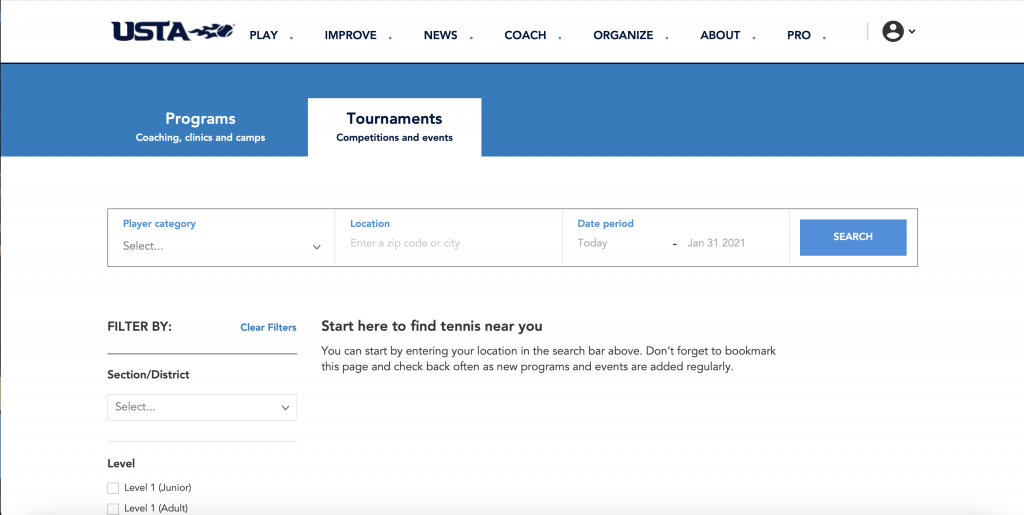A new year brings many things, but when it comes to Junior Tournaments, it brings a whole new software, and a new tournament format. Tournaments were previously found on “TennisLink,” but if you have tried signing up for tournaments before, you know how it was not user-friendly. Studies through the USTA found that parents had so much trouble, they would sign up for one tournament, then never sign up again. We are trying to grow the game, and that does the exact opposite. In late December, the USTA introduced Serve Tennis. If you have not yet used the program, you are in for a surprise! This program is so easy to use! Along with the new software, the USTA is using a new level format, along with a new point system.
Tournament Levels
The USTA has gone back and forth with their tournament levels through the years. Previously, they used 7 Levels, then in 2017, they went down to 5 Levels. Now, they are going back to 7 Levels. Here is the breakdown of levels:
- L7 Tournaments – Open Intermediate Sectional Events: 1-day event; 2-match minimum, 4-match maximum. These events are open to anyone. If there is a limited draw, a bottom-up selection process will be used for this level, which means players with no ranking will be selected first. The 12U division will offer green and yellow ball events.
- L6 Tournaments – Open Intermediate Sectional Events: Up to 3-day events; 2-match minimum, 4-match maximum, and open to anyone. Selection process for this level is based on ranking.
- L5 Tournaments – Open Advanced/Intermediate Sectional Events: Up to 3-day events; non-elimination and open to anyone. Up to 36 L5 events will be sanctioned in the Eastern section. Selection process for this level is based on ranking.
- L4 Tournaments – L4 Closed Super Six Events , L4 Closed Empire Cup Doubles , L4 Closed Mixed Dubs and L4 Intra-team competition: Up to 4-day events; Open and Closed events, with Closed events limited to Eastern section players. Selection process for this level is based on ranking.
- L3 Tournaments- National L3, L3 Closed Super Six Events, L3 Closed Empire Cup Doubles and L3 Closed Mixed Dubs: 3+ days National or section events; L3 tournaments will be Closed events limited to Eastern section players. Selection process for this level is based on ranking.
- L2 Tournaments -National L2 and Section/Intersectional Team Competition: 3+ day National events. Selection process for this level is based on ranking.
- L1 Tournaments – National Championships, National Team Events and selected ITF events 4+ day National events. Selection process for this level is based on ranking.
*Bullet points via USTA.com*
Level 6 vs. Level 7: What’s the Difference?
Previously, the most common question was, “What is the difference between a Level 4, and Level 5?” Now, it will be, “What is the difference between a Level 6, and Level 7?”
Level 7
Level 7 tournaments are for the kids who have never played in tournaments before. They are just one day, and typically take a few hours. The kids typically play multiple rounds of a shortened set against the other kids in the division. They are meant to introduce players to the tournament atmosphere without the pressure of playing through a draw. Lastly, most directors do not have a winner. L7s are for making players feel comfortable in the tournament atmosphere. Not only that, but L7s are also for the parents. It is much easier for parents to commit to a few hours in the afternoon one day, than to commit to a whole weekend! The players do need to know how to keep score.
For more information on L7s, click here!
Level 6
With that being said, if your child has played tennis at school, but has never played a tournament, I always recommend a Level 6. Typically the players are mostly intermediate players (but some more advanced players do sign up depending on the sign up). In a L6, players are put into a draw. They take 1-2 days to complete (depending how much a player wins/loses). Players are always guaranteed 2 matches, but that could be the most they play – unlike a L7 where it is equal play.
In general, everyone in a division is placed into a draw. If you win the first match, you continue to the next round, but if you lose the next match you are done. On the contrary, If you lose your first match, you are placed in the consolation draw. Continuing through, you may play more matches, but it is the same as the main draw, the next match you lose, you’re out.
Tournament Format
In addition to the new level format, the USTA announced they will be going to a universal point system. Previously, earning points was often extremely inconvenient, and sometimes unfair. Someone in Northeast Ohio was not allowed to drive 2.5 hours to Pittsburg, so they would have to drive all the way to Wisconsin. In turn, parents used to drive further, and spend more money. Again, we are trying to grow the game; making parents spend money money definitely does not encourage that! Also, some tournaments offered more points, which was completely unfair. Now, it does not matter where you go, a tournament offers the same amount of points.
Want to learn more about the levels, and the new point system? Click here!
Serve Tennis
Now let’s get into signing up for tournaments. Never before has it been this easy to sign up for a junior tournament.
First, go to usta.com.

Next, hover over “Play,” then click on “Tournaments.”

You will then be redirected to the Serve Tennis program.

From there, you have many options. You can choose to search by level, location, date, etc.
This is an exciting new era to the USTA/Junior level tennis. As influencers in the tennis industry, it is our job to grow the game. As a result, this new format, along with Serve Tennis will do just that. Get out there, and play!
Click here to see all of the tennis options we have at Wembley!
